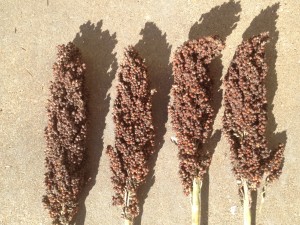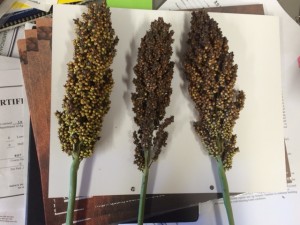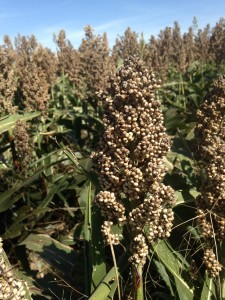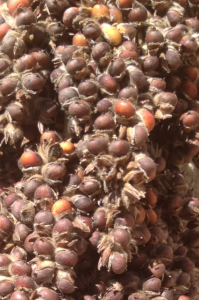Numerous grain sorghum growers in the South Plains, Concho Valley, and lower Panhandle are asking why their grain sorghum heads are so much darker or even black in appearance (Figs. 1 & 2). Even cream grain shows some darkening (Fig. 3). Myself (Dr. Calvin Trostle-Lubbock) along with Texas A&M AgriLife Research sorghum breeder, Dr. Gary Peterson-Lubbock, we have examined several field samples and looked at more pictures.
The darkened color is largely a result of the high level of rainfall received in late September across much of the region. Dr. Peterson notes that this grain response to rainfall and humidity is generally regarded as part of the weathering process of the grain of sorghum. It is something that breeders will select for in that sorghum grain should have some resistance, and the conditions is somewhat common in the Texas Coastal Bend and Lower Rio Grande Valley, especially when harvest is delayed.
The dark color is mostly in the two glumes (one on each side, may cover up to half or more of the seed) which enfold the seed and some of the seed itself is indeed darker in color, but this seed darkening is restricted to the seed coat, and the seeds Dr. Peterson, I, and others split open (growth stage usually hard dough to mature) are starchy white inside (which is normal). Seed that is small is likely a response to conditions prior to or during the rains when grain development was started.
Blackening of the seed itself would be a fungal infection in the seed, and we did not see this. We have not noticed any tendency of this seed to sprout either (though there have been reports of seed sprouting in the South Plains). There are some floral structures in the spikelets that did not develop seed (cause uncertain, Figs. 3 & 4), and these structures (glumes, etc.) are black, which contributes to the darkened appearance of the head. But these ‘blanks’ are not related to any current or recent factor like the rains and cloudy weather. The pollination process would have been complete well before the rains.
Harvest should proceed normally. The seed surface discoloration should not itself significantly impact test weight though fields that have sat through all the rains in West Texas may have lost some quality and might have a lower test weight apart from whether they turned dark or not. The grain in Figs. 1 & 3 could be harvested soon; however, two of the three heads in Fig. 2 are not yet mature.












